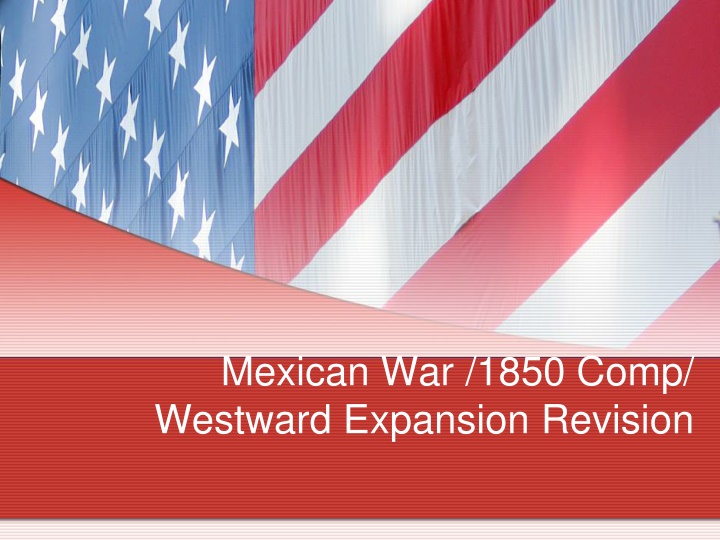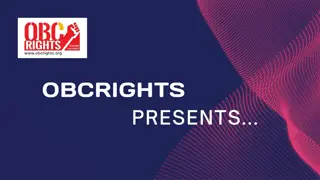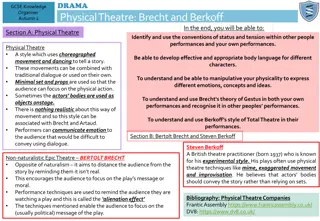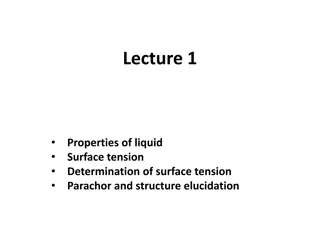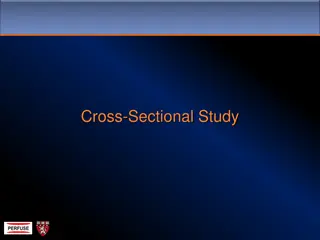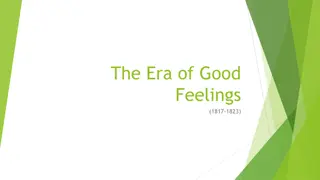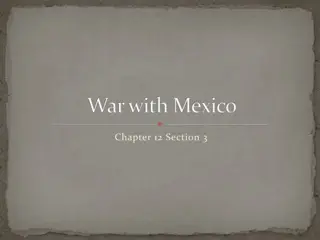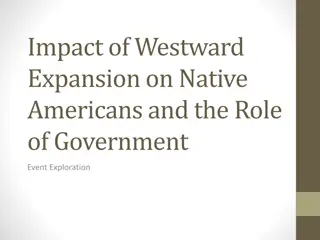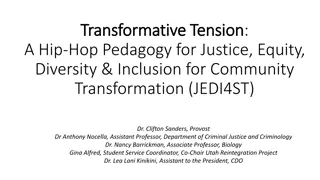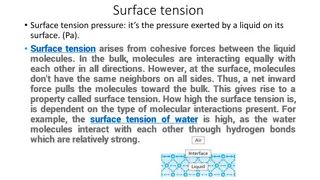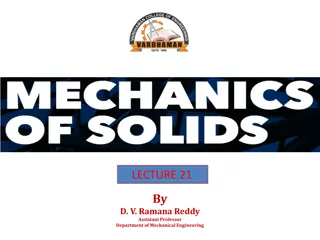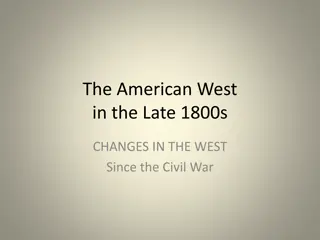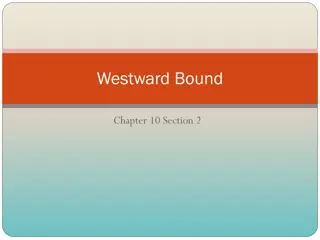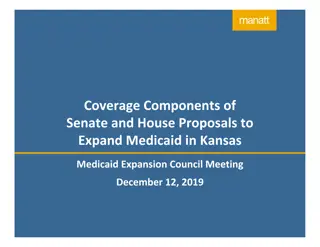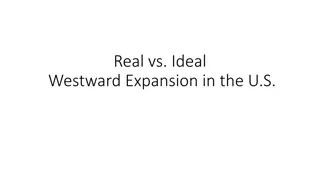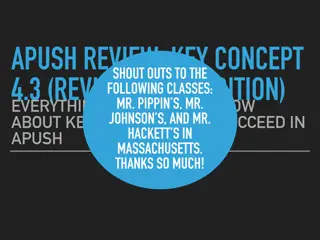Sectional Tension and Westward Expansion: 1845-1854
The period of 1845-1854 was marked by significant sectional tension and debates over westward expansion in the United States. Key events such as the Mexican War, the Compromise of 1850, and the Wilmot Proviso shaped the political landscape of the time. This era saw clashes between North and South on issues like Manifest Destiny, territories acquired from Mexico, and compromises sought in the face of growing tensions. Explore the political climate, key personalities involved, and the impact of westward expansion on the nation during this crucial period.
Download Presentation

Please find below an Image/Link to download the presentation.
The content on the website is provided AS IS for your information and personal use only. It may not be sold, licensed, or shared on other websites without obtaining consent from the author.If you encounter any issues during the download, it is possible that the publisher has removed the file from their server.
You are allowed to download the files provided on this website for personal or commercial use, subject to the condition that they are used lawfully. All files are the property of their respective owners.
The content on the website is provided AS IS for your information and personal use only. It may not be sold, licensed, or shared on other websites without obtaining consent from the author.
E N D
Presentation Transcript
Mexican War /1850 Comp/ Westward Expansion Revision
The Spec Westward expansion and its impact on North and South: the ideas of Manifest Destiny; controversy over the new territories acquired by victory over Mexico Attempts at political compromise: the Wilmot Proviso; the role of personalities such as Zachary Taylor, Stephen Douglas and Henry Clay; the Compromise of 1850; Texas and California; the Fugitive Slave Law
Big themes 1845-1854 Big Picture Key Events There was increasing tension on a range of key issues. In Congress voting was often on sectional lines. Both sides accused the other of being too power full wanting to impose their views on the other side. Sectional Tension The gaining of land from Mexico led to major issues between North and South and did the issue of Cuba as well as Kansas and Nebraska. Both sides mistrusted the other s motivation but Manifest Destiny was supported in both North And south Westward Expansion Although there was tension, arguments and strong disagreements on key issues there were compromises sought and in several occasions reached between the two sides suggesting that relations had not completely collapsed. Compromise
Big themes Key Events Texas joins the Union Mexican War Wilmot Proviso Calhoun Doctrine Treaty of Guadalupe Hidalgo President Taylors actions re- California and New Mexico. Fugitive Slave Act Ostend Manifesto Sectional Tension Texas Mexican War Oregon/ Britain Wilmot Proviso Calhoun Doctrine Treaty of Guadalupe Hidalgo Gadsden Purchase Ostend Manifesto Popular Sovereignty Kansas-Nebraska Act Westward Expansion Texas- single state Treaty of Guadalupe Hidalgo 1850 Compromise Gadsden Purchase Kansas- Nebraska Act Compromise
Timeline Place the key events on a timeline Colour code the three key themes (some events will be in multiple themes)
Essay Questions Task Intro Paragraph headings Conclusion Sectional Tension was a serious threat to the Union in the years 1848 to 1854 Assess the validity of this view Sectional Tension Key arguments for Key arguments against Other potential driving forces Westward Expansion was the driving force of sectional tension in the years 1845 to 1854 Assess the validity of this view Westward Expansion To what extent was compromise the key characteristic of North-South relations in the years 1845 to 1854? Criteria Conclusion Compromise
1845-1854 Abolitionism
The growth of abolitionist sentiment in the North: political leaders such as William Seward; activists such as John Brown; popular literature and the press; the cultural and economic influence of European immigrants arriving in the northern states Reactions against abolitionism in the South; political leaders such as Jefferson Davis; popular literature and the press
Press and literature Uncle Toms Cabin William Lloyd Garrison- The Liberator Frederick Douglas- North Star
Activists William Lloyd Garrison Frederick Douglas John Brown
Impact of Abolitionists on relations between the North and the South Did have an impact on North-South relations Did not have an impact on North- South relations
Political Leaders William Seward (named in the spec) Seward opposed the 1850 Compromise, delivering his famous higher law speech in which he argued there were higher laws than the Constitution. His home was a safehouse on the underground railroad in the 1850. Seward opposed the Kansas -Nebraska Act. He was a early member of the Republican Party. After 1854- In 1858 Seward attacked the Dred Scott decision in the Senate. He stated in 1859 that there was an irrepressible conflict coming, Southerners said this led to John Brown s raid. In 1860 Seward was not selected as the Republican Presidential candidate for being too radical. But there is evidence that he was not an abolitionist During the period: Seward supported and worked closely with the slave owning President Zachary Taylor. After the time period: In 1856 Charles Sumner was told to moderate his speech that led to him being attacked by Seward. Seward condemned John Brown and believed his execution was justified. In 1860 Seward worked towards a compromise and a Constitutional Amendment that would stop Federal Government from interfering in slavery where it existed.
Martin Van Buren- won presidency in 1836 (democrat) stating he opposed abolitionism but by 1848 he openly supported abolitionism and Presidential nominee for the Free Soil Party he won 10% of the popular vote but no electoral college votes. He disliked the Republican Party
John C. Fremont- fought in Mexican War and was a renowned explorer. Senator for California 1850-51. In voted favour of abolition in Washington D.C. and against the Fugitive Slave Act. He only served 175 days as Senator. He later ran as the Republican Presidential Candidate in 1856
Create a Spider Diagram Press and Literature Abolitionism Political Leaders Activists
Last Years Exam Q How accurately did popular literature and the press in the South represent Southern attitudes to abolitionism, in the years 1850 to 1854? [25 marks]
Mark Scheme For Arguments/factors suggesting that popular literature and press in the South accurately represented Southern attitudes to abolitionism, in the years 1850 to 1854 might include: The production of anti-Tom literature such as The Planter s Northern Bride and The Sword and the Distaff , can be seen as mirroring the Southern desire to defend their peculiar institution Reports of Northern resistance to the Fugitive Slave Law and efforts to free fugitive slaves, such as Anthony Burns in 1854, helped form Southern attitudes to abolitionism and therefore accurately represented them Southern politicians Calhoun, Jefferson Davis and other so called fire-eaters , spoke out against the dangers of abolitionism matching the views expressed in popular literature and press. This suggests that popular literature and press were accurately representing Southern views as they matched those expressed by elected politicians The South brought in stricter restrictions on slaves in a reaction to fears over the impact of abolitionist literature and activists, suggesting that press and literature were in line with the views of the people in the South regarding abolitionism.
Mark Schem Against Arguments/factors challenging the view that popular literature and press in the South accurately represented Southern attitudes to abolitionism, in the years 1850 to 1854 might include: anti-Tom literature failed to sell in anything like the numbers of Uncle Tom s Cabin and certainly did not have the impact of Uncle Tom s Cabin anti-Tom literature , depicted abolitionists stirring up slave unrest and carrying out terrible acts, whilst in reality there was very little evidence of abolitionists having any notable impact amongst the slave population President Pierce s policies, including the Gadsden Purchase and attempts to purchase Cuba, suggest that the South had little to fear from abolitionism damaging their interests, this was not reflected in the Southern Press which gave an impression of rampant abolitionism in the North. The views expressed in the press did not match the views of many in the South only a minority of Southerners owned slaves and therefore the press and literature did not reflect the fears of many in the South but rather that of the planter class. Many in the South saw little to fear from abolitionism following the 1850 Compromise.
Mark Scheme Conclusion Overall, students can argue either for or against popular literature and press in the South exaggerating the South s reaction to abolitionism. Students might argue that the press and literature led to a strong reaction against abolitionism in the South rather than simply reflected it. Key debate is likely to focus around the reaction to Uncle Tom s Cabin and how abolitionism was portrayed to people in the South compared to the reality of genuine feelings in the South. Students may conclude that there was a genuine fear of abolitionism in the South or that the majority were more concerned with arguments of whether slavery would be allowed to spread into new territories than abolitionism.
Examiners Report This was the least popular of the three essays. It is based on the specification content: Reactions against abolitionism in the South; political leaders such as Jefferson Davis; popular literature and the press . It is noted that the questions proved to be highly challenging for students and did not perform as well as the other essay questions. Whilst students demonstrated strong knowledge on abolitionist writings especially Uncle Tom s Cabin and newspapers such as The Liberator , knowledge on the Southern Response to this was much less secure. Some answers displayed good knowledge of individual or numerous examples of anti-Tom literature in particular The Planter s Northern Bride in which the villains are abolitionists. Other strong answers focused on comparing the sales of abolitionist and anti-abolitionist literature and the attitudes in the press. Students could have compared the views in literature/ press to those held by political leaders to illustrate how typical the views were. Many students focused on arguments surrounding expansion of slavery at this point in time, which whilst understandable was only effectively linked back to the question by a minority of students. Abolitionism is a key concept and it is essential that students can assess the attitudes to it across the sectional divide. A large number of students went beyond 1854 with a large amount of material about 1856 being produced and some going as far as Harper s Ferry in 1859. This material could not be credited given the time constraints on the question that match those in the specification.
1854-61 Rise of the Republicans
The Spec The emergence of the Republican Party: the political impact of the controversy over the Kansas-Nebraska Act; the spread of Republican parties across northern states; the elections of 1856; key personalities including Lincoln, Seward and Chase
The Whys Kansas- Nebraska Collapse of the Whigs Failure of the Know-Nothings Growth of abolitionism/ opposition to the spread of slavery Fremont Lincoln-Douglas Debates Dred-Scott Buchannan
Which Why is the most significant? Rank them from 1-8 Write a paragraph on each of your top 4 explaining why they are significant. Assuming your top choice was the focus of the Q: To what extent was X the most important reason for the growth of the Republican Party? Write an introduction and Conclusion
For example I would pick the Kansas-Nebraska Act because: It meant that the issue of the expansion of slavery became the key issue in American politics and led to the growth of the Republican party in the North as stopping the expansion of slavery was their key policy. The Kansas Nebraska Act impacted on the position in the north of all of the other parties in a negative way: Democrat Stephen Douglas was behind the Kansas Nebraska Act meant that many in the North turned away from the Democrats; It destroyed the Whig Party as they could not agree on a policy leaving room for the Republican Party to fill; The Know Nothing Party didn t take a strong stance on Kansas Nebraska (wanted to win votes in both the North and South) and were focused on immigration rather than slavery. The violence in Kansas highlighted the strength of feeling on this issue.
The Hows Anger in the North caused by the Kansas-Nebraska Act led to the need for a new anti-Slavery/ anti-expansion of slavery party as neither the Whigs or Know-Nothings could fulfil this role. The Republicans performed well in the 1856 election as slavery and the slave power conspiracy carried more importance with the Northern electorate than immigration. Buchannan s Presidency was so pro-Southern that Northern voters increasingly turned to the Republicans. Dred-Scott seemed to prove the Slave Power Conspiracy was real. Lincoln gained national recognition for his performance in 1858 debates against Douglas. 1859- Republicans distanced themselves from the raid on Harper s Ferry 1860 Election- split in Democrats, even more moderate Douglas was unpopular in much of North due to Kansas-Nebraska
How Task Recreate the previous slide in a flow diagram
The Impact End of second party system Increased sectional voting South feared Republican Party, as in the South it was portrayed as being abolitionist. Proved that the North could elect a President the South universally opposed.
How would you approach this essay The most significant impact of the rise of the Republicans was the end of the Second Party System Assess the validity of this view
Fact Files on Leading Republicans Abraham Lincoln William Seward Salmon P. Chase
